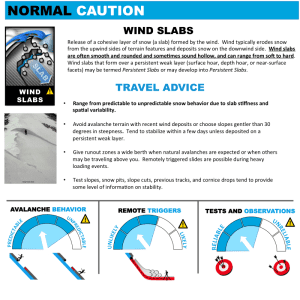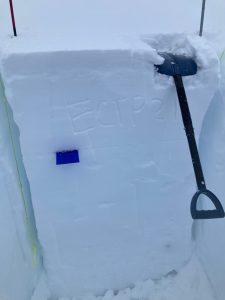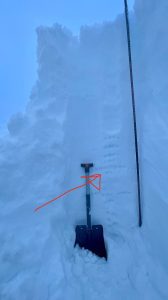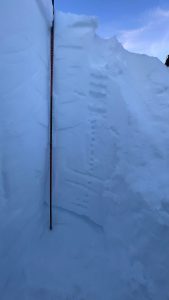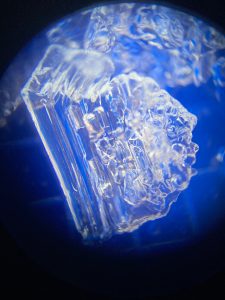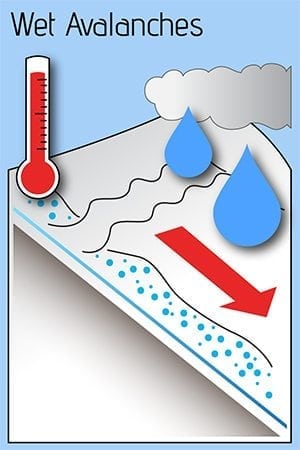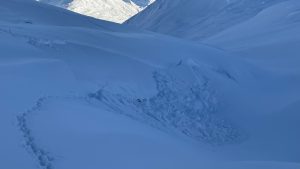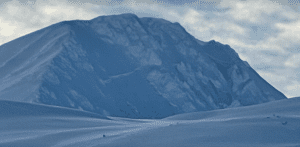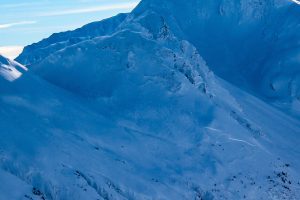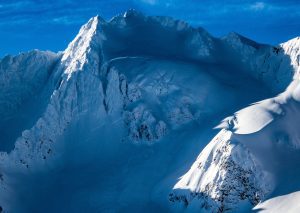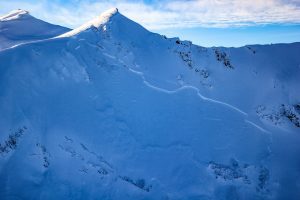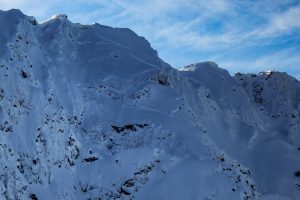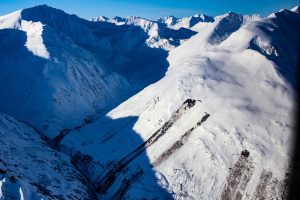Haines Avalanche Center
Above 2,500ftModerate
1,500 to 2,500ftLow
Below 1,500ftLow
Degrees of Avalanche Danger
Avalanche Problems
Problem 1
The Bottom Line: Sunshine and fresh snow can be intoxicating, don’t let your guard down. We need to keep the avalanche problems on our minds and always utilize safe travel technique by limiting our exposure to slopes greater than 30 degrees. A hard crust has formed where rain levels reach well above tree-line possibly up to 5,000′ in the Lutak Zone. At elevations above tree-line where softer snow was preserved, sensitive wind slabs have been reactive to human triggers and new slabs are forming from the north wind. Avoid steep wind loaded areas and be wary of isolated pockets of buried surface hoar. Look for recent avalanches, try to assess how deep they ran, and be sure to avoid similar slopes.
Never expose more than one person at a time to slopes 30-degrees and steeper. Don’t enter avalanche terrain without a plan for how to manage an avalanche that could break far wider and larger than you expect. If a surface wind slab were to let loose, it could possibly step down to deeper weak layers. Look for signs of instability including: natural avalanches, shooting cracks and collapses, flagging or visible wind transport of snow.
Likelihood:
- Almost Certain
- Very Likely
- Likely
- Possible
- Unlikely
Size:
- Historic
- Very Large
- Large
- Small
Trend
- Increasing
- Steady
- Decreasing
Problem 2
As of Friday, we have evidence of a widespread avalanche cycle on deep persistent weak layers (see avalanche activity). We should remain aware that very deep and wide destructive avalanches need to still be considered and planned for accordingly. Pay attention to run-out paths and leave wide margins of safety for larger than expected slides. Terrain management continues to be critical. An avalanche in the upper snowpack or cornice failures could step down and lead to a massive avalanche.
Think about the terrain. How would a hard slab be connected, from where you are standing? If something is triggered on a steep slope or in a thin area nearby, does that slab connect to you, or above you? What about the rest of your group? Avoid these area and always limit exposure to avalanches slopes by traveling one at at time.
Buried Surface Hoar Layers:
- January 10th (pictured below on the 10th and then the 22nd) is now buried about 2-4 feet deep. It was likely active during this week’s storm cycle. Reports of remote-triggered activity on this layer 1/27.
- The Dec 31 surface hoar layer is present in the Transitional and Pass zones, about 4ft deep. This layer has been active in pits, and caused some natural avalanches in early January
- Buried SH layers are tricky — they’re hard to find, and may only exist in wind-protected areas. But anywhere they are present you should be highly suspicious of that slope. It would be best to avoid wind-protected pockets that may be harboring this dangerous weak layer. Make continual assessments on test slopes and with stability tests.
Old Melt Layers and Crusts:
- A buried persistent weak layer about 6+ feet deep (The “Big Warmup” Layer, Formed Nov 17th) is still a concern. Numerous natural avalanches observed 1/27 likely on this layer.
- A wide safety margin is necessary. This setup could produce avalanches that break wider than expected, and are most likely to be triggered from shallow trigger points like rocks or small trees. You could ride the same slope numerous times until that right spot produces a large destructive slide.
Photos of the “Big Warmup” facet layer in the Transitional Zone at 2500ft on 1/2 with test results ECTP18 that demonstrated propagation potential on this layer & Photo from Old Faithful on 1/12 of a 5″ thick layer of facets down 170cm.
Depth Hoar at the Ground (Above 3,000′):
- October snow followed by long cold snaps created depth hoar at the ground in most areas.
- You are most likely to human-trigger this layer from shallow spots around rocks, or trees, or have a surface avalanche step down to the ground on this layer. Any slides that break to the ground are likely to be deadly.
Photos shows 6-9mm advanced depth hoar at the ground down 180cm with ECTP 25 down 80cm on facets below a crust in the Haines Pass Zone at 4,000ft on a NE-aspect.
Likelihood:
- Almost Certain
- Very Likely
- Likely
- Possible
- Unlikely
Size:
- Historic
- Very Large
- Large
- Small
Trend
- Increasing
- Steady
- Decreasing
Problem 3
Below 3000ft:
Lingering water in the upper snowpack, or free flowing water underneath may keep wet slides possible in middle elevations today. You can avoid this danger by sticking to slopes less than 30 degrees, and staying out of gullies and terrain traps that funnel snow from above. Steep slopes (40 degrees and steeper) will be especially prone to large wet loose or wet slabs. This danger will linger until temperatures drop enough to freeze the upper snowpack in place.
Likelihood:
- Almost Certain
- Very Likely
- Likely
- Possible
- Unlikely
Size:
- Historic
- Very Large
- Large
- Small
Trend
- Increasing
- Steady
- Decreasing
Avalanche Activity
January 27th:
Remotely triggered D2 West Nadahini Creek above 4,000′ failed 2-7′ deep on an isolated terrain feature.
Natural activity from this week:
D3 NE aspect 6000′ near Nadahini with widespread propagation.
D3 cycle between 3000-6000ft. All aspects. Most were unsupported slopes or rocky areas. Crowns 1-3m deep, ran just above ground.
Multiple D2 that ran about 2ft deep. In wind protected areas.
2000-3000ft widespread full depth wet slabs and glide avys, all aspects.
D2 N aspect 4300ft sub bowl of Old Faithful failed down to near ground, Was confined to a smaller pocket.
D3 on SW aspect at Lutak Inlet, ran down to the water
D4 on Takhin Ridge
Weather
Forecast:
A sunny Sunday skies will start to get cloud cover in the evening. Light NW winds. Temps near 20. Currently early next week snow totals look like not much more than a few inches.
Recent Weather Summary:
- Jan 17-26 brought around 5″ of precip (3-5feet of new snow above 3000ft), strong SE winds, and a noticeable warmup
- Surface Hoar and Near Surface Facet growth Jan 8-10
- A strong front brought 24-30″ of snow above 2000ft on Jan 2nd.
- There was widespread Surface Hoar growth on Dec 31st.
- Dec 23-26 brought 10-18″ of new snow and a sharp rise in temperatures from -10F to 30F along with variable winds
- Dec 16-23 brought strong NW winds and arctic cold temperatures
- Dec 15 brought warmth/light rain up to 2600ft
- Complete Season Histories: Transitional Zone Lutak Zone
| Snow Depth | Last 24-hr Snow/SWE | Last 3-days Snow/SWE | Today’s Freezing Level | Today’s Winds | Next 24-hr Snow/SWE | |
| Mount Ripinsky @ 2,500′ | 90″ | 0″ / 0.00 | 0″ / 0.00″ | 0′ | mod, NW | 0″ / 0.00″ |
| Flower Mountain @ 2,500′ | 52″ | 0″ / 0.00″ | 0″ / 0.00″ | 0′ | mod, NW | 0″ / 0.00″ |
| Chilkat Pass @ 3,100ft | 40″ | 0″ / 0.00″ | 0″ / 0.00″ | 0′ | mod, NW | 0″ / 0.00″ |
Additional Information
WEAR A HELMET! Be careful of rocks and hidden hazards. Be prepared for crevasses when on a glacier.
Are your riding companions trained and practiced in avalanche rescue? Everyone in your group needs to have a beacon, shovel, and probe, and know how to use them. Our mountains have very limited cell coverage, carry an emergency communication device and enough gear to spend the night.
Avalanche Canada’s Daily Process Flow – Utilize this every day you go out in the mountains.
Announcements
Click the +Full Forecast link below for each zone to read more. If you see any recent natural avalanche activity, or signs of instability please submit an observation.
